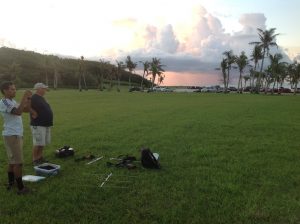Research on the Coconut rhinocerous beetle by two Eastern Mennonite University students and one professor was recently published in the scientific journal Environmental Entomology and featured on the news site of the Entomological Society of America, Entomology Today. Modern advancements in the miniaturization of radio transmitters allowed Professor Matthew Siderhurst and biochemistry majors Diego Barahona and Kat Lehman to employ the “Judas technique” in following tagged beetles to breeding sites on Guam.
“Because adults tend to aggregate at the places where they lay their eggs, we speculated that it would be possible to find areas with dense populations of this pest insect by tracking individual beetles,” says Lehman.

Siderhurst has worked on several agricultural pest projects in Hawai’i, Guam, and Australia since earning his PhD in entomology from Colorado State University. He and his students were joined by University of Guam researchers in August 2015 for this endeavor, funded by a USDA Forest Service grant. Siderhurst has taken students researchers to Hawai’i and Guam almost every year since he came to EMU a decade ago.
As of 2010, a Coconut rhinocerous beetle genetically specific to Guam (called CRB-Guam) had infested all parts of the island, and has also spread to Hawai’I, Papau New Guinea and the Solomon Islands, and threatens reaching California. The pest destroys coconut palms – which are “culturally and economically important throughout the Pacific,” explains Siderhurst, and valuable as ornamentals in the U.S. CRB-Guam damages other commercially viable crops, including bananas, sugarcane, papayas, sisal, pineapples, taro and date palms.
“The only proven tactic for eradication [of this specific beetle] is a vigorous sanitation program that discovers and destroys all active and potential breeding sites,” the research team reports in their abstract. But to purge a breeding site, one must find it – whether buried underneath barrels or six meters above the ground in a broken branch.
The EMU team and colleagues initially trapped individual beetles using pheromones. The “large, powerful” beetles were collected, fed fresh banana slices, and allowed to rest before having a tiny radio transmitter attached to their backs. Then, at dusk, the researchers released the beetles and began tracking their flights. The beetles’ final locations were noted at dark, and the next morning, the team would resume the search – hoping their “Judases” would betray breeding sites.
“This involved trekking through tangles of rainforest scrub and digging up beetles as we could find them,” says Lehman.
Guam, which has been a U.S. Territory since 1898, has a tropical marine climate which made for “a real workout hunting for the insects.”
The Judas technique has been used in a variety of species for feral animal control, but this is its first use with insects.
“This study was a success in that all but one of the 34 radio-tagged beetles flew, and the majority of these beetles were tracked to final landing destinations including definite breeding sites,” the researchers conclude. This type of field work “…with conspecifics [members of the same species] provides an advantage that cannot be rivaled by present tracking techniques.”
“I think the impacts [of these trips] are similar to cross-culturals in many ways, as well as providing excellent opportunities to engage in hands-on research,” says Siderhurst.
“It was certainly eye-opening to go through the entire process of planning an experiment, conducting research, analyzing data, and producing a publication from start to finish,” says Lehman. “Not many undergraduates are privileged enough to get that experience.”
